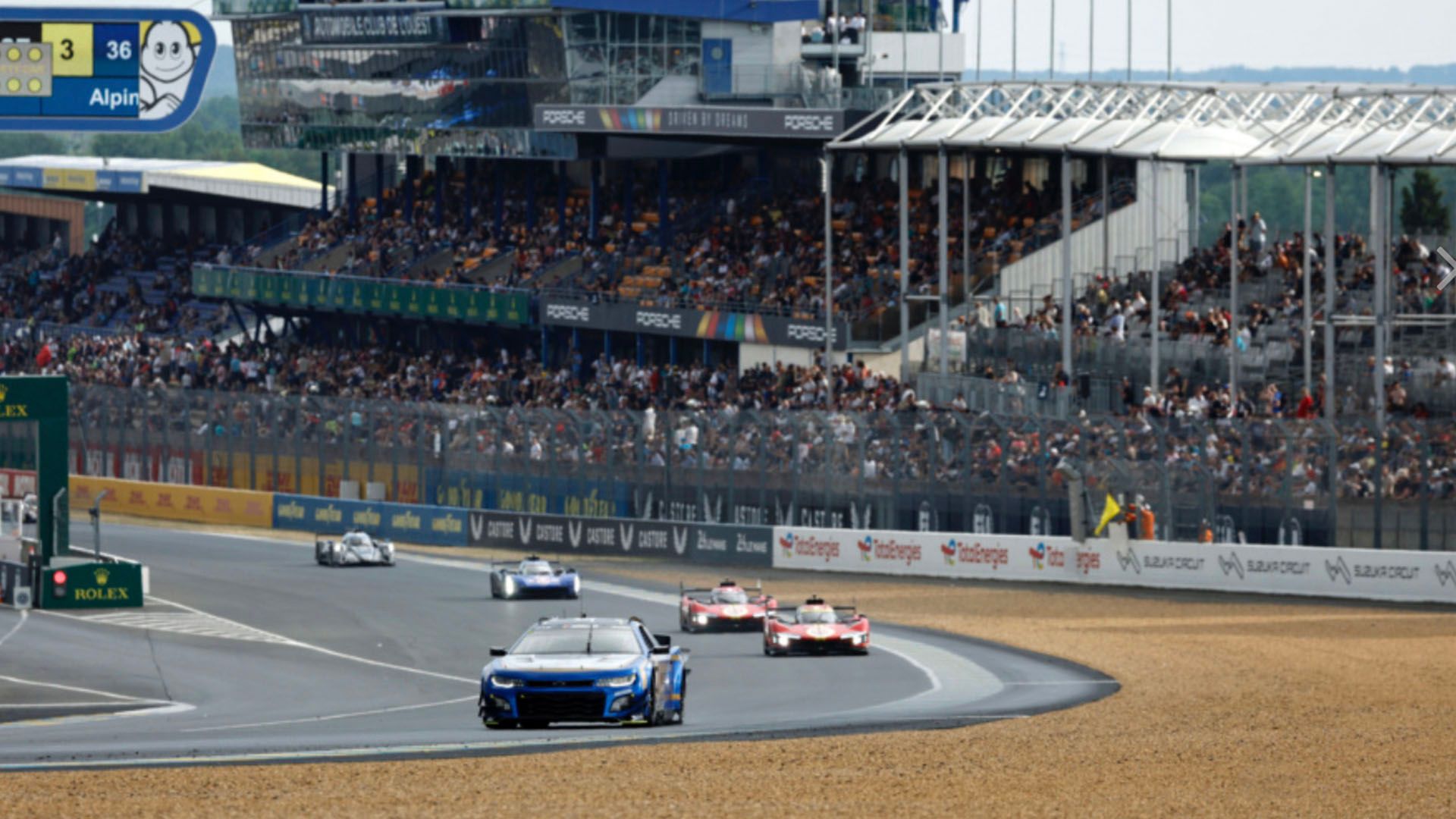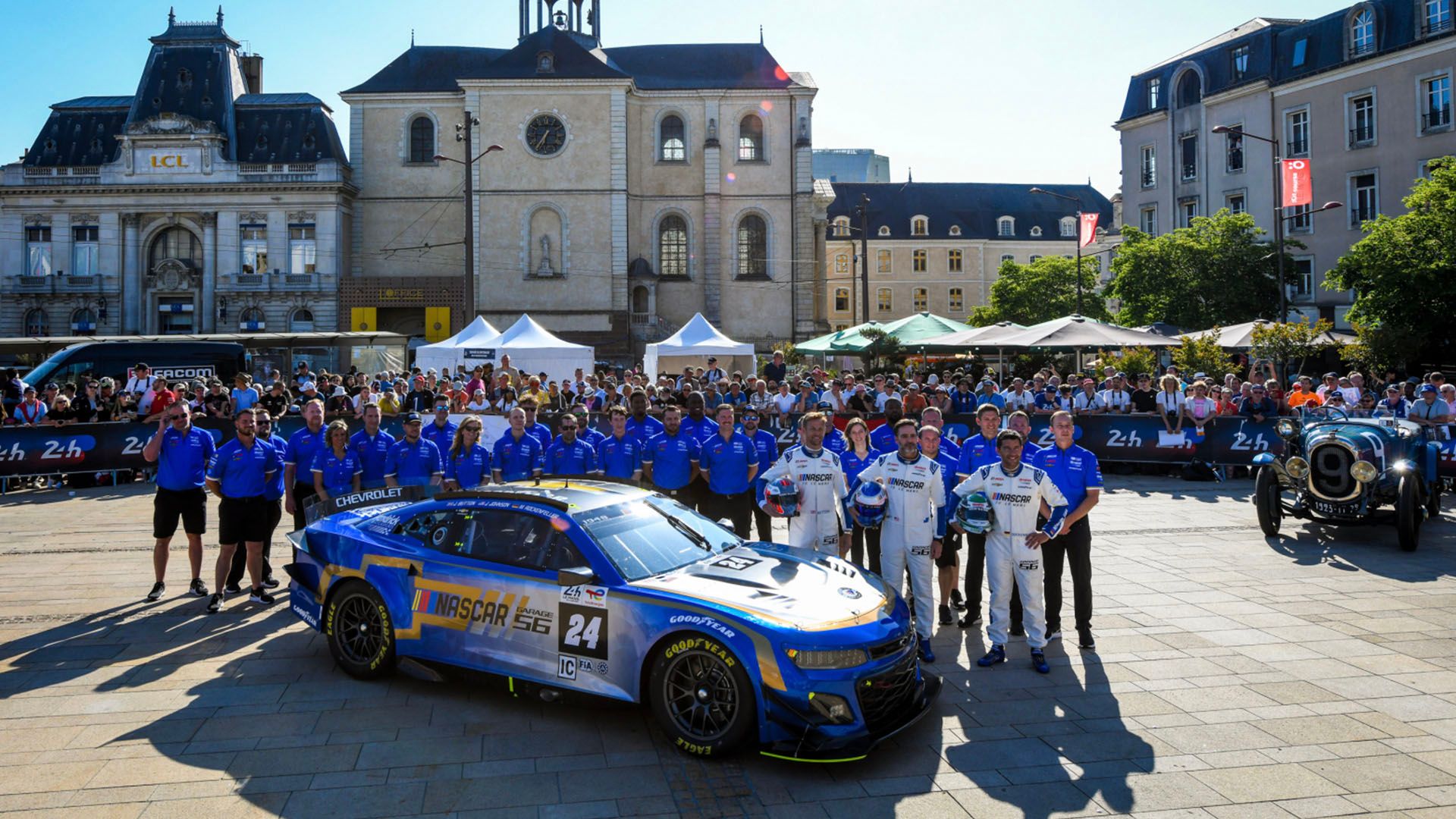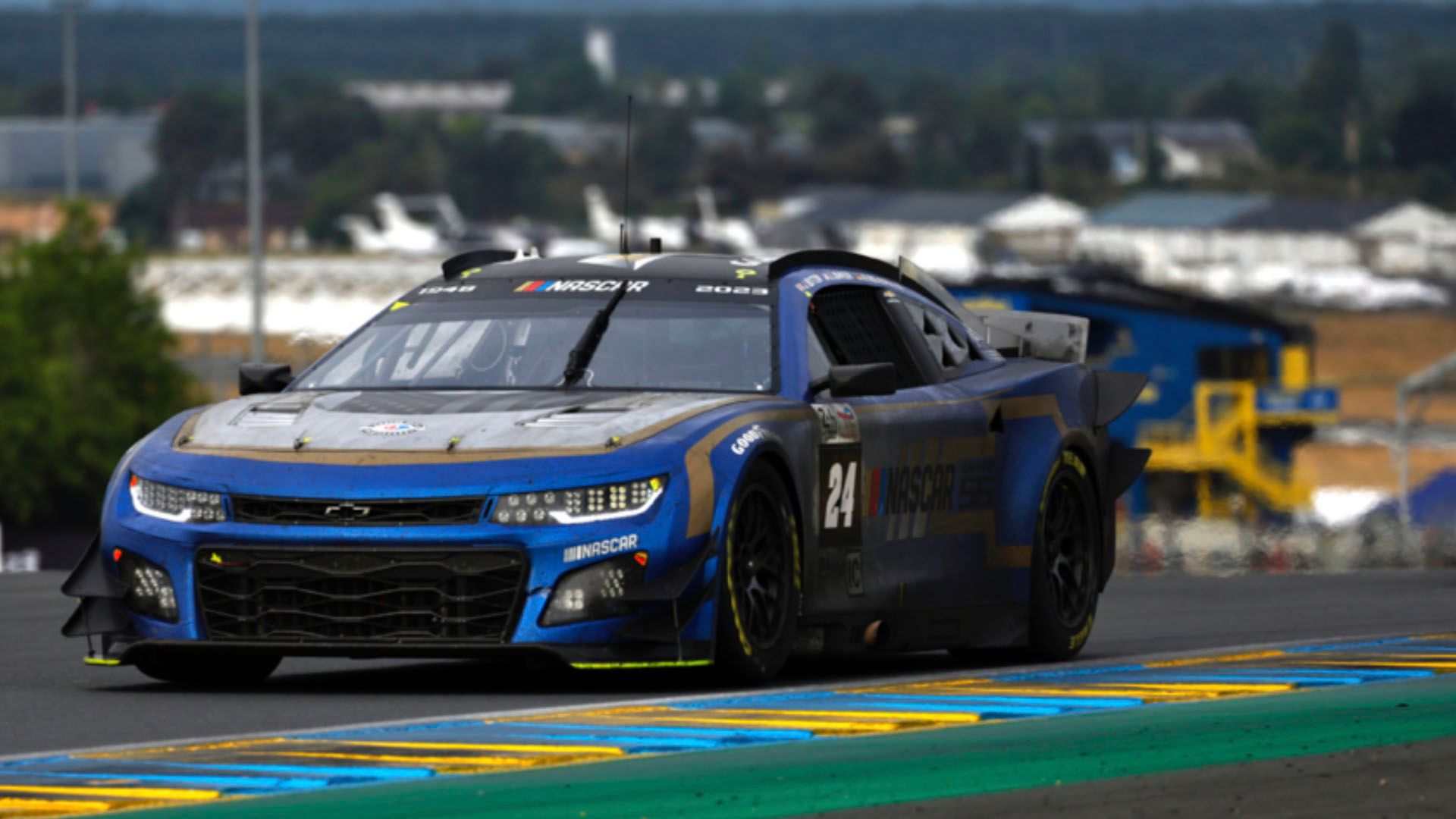In 2023, the 24 Hours of Le Mans saw a surprising entry: a modified NASCAR stock car from Hendrick Motorsports. This Camaro ZL1 was designed to compete not only against GTE cars from renowned brands like Ferrari, Porsche, and Aston Martin but also against high-performance hypercar prototypes on the track.
Chevrolet, a major division of General Motors, has been a well-known name since it was founded in 1911.
The company is recognized for producing reliable and affordable vehicles, and the Camaro is one of its standout models.
For this special race, the Camaro was driven by a team of skilled drivers, all of whom have championship experience. The car’s distinctive look set it apart from the sleek GTE cars, but its impressive performance on the track was what truly captured attention.
Contrary to expectations, the NASCAR Camaro actually outpaced the Ferrari, Aston Martin, and Porsche GTE cars, competing under special rules that allowed for its entry.
This race aimed to challenge the common belief that stock cars are only suitable for oval tracks, proving that they can excel in endurance racing as well.
NASCAR Camaro Takes on Le Mans A Bold Experiment
In 2023, the legendary 24 Hours of Le Mans featured an unexpected entry: a modified NASCAR Camaro stock car. This unique vehicle was part of an experimental program known as Garage 56, which allows for special entries that do not have to follow all the usual racing regulations.
Hendrick Motorsports, a top team in NASCAR, decided to put this Camaro ZL1 to the test on one of the world’s most challenging racing stages.
Innovative Modifications
The Camaro ZL1 entered Le Mans with significant updates thanks to NASCAR’s “Next-Gen” stock cars. These changes included improved aerodynamics, a new rear diffuser, center lock wheel nuts, and larger wheels.
These enhancements were designed to make the car more competitive, especially on road courses. Traditionally, NASCAR races are held on oval tracks, but in recent years, NASCAR has been expanding its events to include road courses like the Circuit of the Americas, Watkins Glen, and the Charlotte Roval.
This shift made it possible for a stock car like the Camaro to compete in an endurance race like Le Mans.
A Star-Studded Driver Lineup

To pilot the Camaro at Le Mans, Hendrick Motorsports assembled a talented trio of drivers. NASCAR legend Jimmie Johnson, who has seven championships under his belt, joined forces with Jenson Button, the 2009 Formula 1 world champion, and Mike Rockenfeller, a two-time Le Mans winner.
This combination of expertise brought a wealth of experience to the team and heightened expectations for the Camaro’s performance.
Surprising Performance on the Track
Despite initial doubts about the Camaro’s ability to compete against the high-performance GTE cars from brands like Ferrari and Porsche, the stock car quickly proved its capabilities.
In qualifying, the NASCAR Camaro shocked many by being four seconds faster than the fastest Ferrari GTE car. This impressive time indicated that the Camaro was not only fast on the straights but could also handle the demands of the road course.
Overcoming Expectations
Throughout the race, many observers believed the Camaro would struggle with cornering and handling. However, it became clear that the modifications had transformed the vehicle into a serious competitor.
The Camaro maintained its pace and proved that it could the twists and turns of the Le Mans circuit with skill. While the team ultimately finished 39th, the performance of the Camaro in such a prestigious event was a noteworthy achievement for NASCAR.
Breaking Barriers
The entry of the NASCAR Camaro into Le Mans represented more than just a new racing venture; it was a chance to challenge stereotypes about stock cars. Traditionally, stock cars are seen as vehicles suited only for oval tracks, but this experiment demonstrated their potential in diverse racing environments.
The success of the Camaro at Le Mans could pave the way for more innovative entries in the future, showing that with the right modifications, stock cars can thrive in endurance racing.
The NASCAR Camaro’s participation in the 2023 Le Mans was a groundbreaking moment for both NASCAR and Hendrick Motorsports.
With its advanced technology, skilled drivers, and remarkable performance, the Camaro not only challenged expectations but also showcased the versatility and capability of stock cars.
As the world of motorsport continues to, this bold experiment may lead to new opportunities for stock cars to compete in prestigious endurance races around the globe.
NASCAR Camaro’s Impressive Performance at Le Mans A Race to Remember
In 2023, the NASCAR Camaro made headlines during the 24 Hours of Le Mans as it raced under the special Garage 56 entry.
This unique opportunity allowed the Camaro to compete without needing to adhere to the usual balance of power (BOP) regulations that govern other racing classes.
While the Camaro was required to start from the back of the grid, it quickly showed its potential on the track.
Qualifying Success
During qualifying, the modified Camaro ZL1 stock car stunned everyone by setting a time of 3 minutes and 47.9 seconds.
This impressive performance outpaced every car in the GTE class, including the fastest qualifying time of 3 minutes and 51.9 seconds set by the Ferrari 488 GTE Evo.
With a full four-second lead, the Camaro’s speed highlighted the effectiveness of its modifications and the skill of its drivers. Because of its strong qualifying performance, race officials allowed the Camaro to start ahead of the entire GTE class on race day.
A Memorable Race Experience
As the race began, the Camaro ZL1 stood out not just for its speed but also for its distinctively loud engine noise. This roar became a memorable aspect of the race, capturing the attention of fans and competitors alike.
Despite racing against elite GTE cars from manufacturers like Ferrari and Porsche, the Camaro held its ground and proved to be a competitive entry in the field.
However, the race was not without its challenges. During the grueling 24-hour event, the Camaro experienced a transmission failure.
Regulations at Le Mans typically prohibit a mid-race gearbox change, but an exception was made for the special Garage 56 entry. Despite this, the necessary repairs caused the team to lose ten positions in the process.
Final Results
By the end of the race, the trio of accomplished drivers—Jimmie Johnson, Jenson Button, and Mike Rockenfeller—managed to complete 285 laps, covering a total distance of 2,415.66 miles.
The team finished in 39th place, a respectable outcome considering the unique challenges they faced. Additionally, the Camaro was classified 10th in the GTE category, demonstrating its competitiveness against traditional GTE cars despite being a modified stock car.
Breaking New Ground
The NASCAR Camaro’s performance at Le Mans not only showcased the car’s capabilities but also challenged the perception of stock cars in endurance racing.
Traditionally, stock cars have been associated primarily with oval track racing, but the success of the Camaro illustrated that with the right modifications and drivers, they can excel in road course racing as well.
This venture into Le Mans marks an important moment for both NASCAR and Hendrick Motorsports.
It opens the door for future possibilities in endurance racing, encouraging innovation and collaboration between different racing formats.
The 2023 Le Mans was a landmark event for the NASCAR Camaro. From its surprising qualifying times to overcoming mechanical issues during the race, the Camaro demonstrated not only speed but resilience.
By finishing respectably among top-tier competitors, it proved that stock cars are capable of more than just turning left. As the motorsport world evolves, the success of the Camaro at Le Mans may inspire new avenues for stock cars to participate in various racing formats, making it an exciting chapter in automotive racing history.
Upgrades to the Next-Gen NASCAR Camaro for Le Mans Racing into the Future
In 2023, Hendrick Motorsports made history by entering a modified NASCAR Camaro ZL1 stock car in the prestigious 24 Hours of Le Mans.
To compete effectively in this challenging endurance race, the Camaro underwent significant modifications, showcasing the adaptability of stock cars in various racing formats.
This article the key upgrades that transformed the Camaro into a formidable contender for the grueling 24-hour race.
Enhanced Engine Performance
One of the most critical modifications made to the NASCAR Camaro was the engine tuning. The V8 engine, which typically produces between 510 and 670 horsepower in stock car racing, was specifically tuned to reach 750 horsepower for the Le Mans race.
This increase of 150 horsepower over the GTE category cars, which are limited by balance of power (BOP) regulations to around 600 horsepower, gave the Camaro a competitive edge in terms of raw power.
To ensure reliability during the extended race, the team implemented a rev limiter. This allowed the engine to operate safely within its limits, even though it was capable of producing more than the 750 horsepower it was set to deliver.
This adjustment was crucial, as the 24-hour race requires consistent performance over a long period, making reliability as important as speed.
Advanced Transmission System
While the Camaro retained its stock car trans-axle, a significant upgrade was made to the transmission system. The traditional sequential shifter was replaced with an F1-style steering wheel that featured paddle shifters.
This change improved the driver’s ability to shift gears quickly and efficiently, an important factor in endurance racing where every second counts.
Superior Braking Technology
Braking is critical in any racing event, especially in an endurance race where drivers face various conditions over many hours. To enhance stopping power, the team equipped the Camaro with a full carbon braking system.
This upgrade not only improved the car’s ability to decelerate quickly but also helped manage heat better during extended driving, ensuring that the brakes remained effective throughout the race.
Aerodynamic Enhancements
One of the standout modifications to the Camaro was its aerodynamic upgrade. The team focused on improving downforce, which is essential for maintaining speed and stability, especially in corners.
The Camaro featured large front planes, a pronounced front splitter, massive rear canards, and a larger rear spoiler. Together, these components increased the car’s downforce by 50 percent compared to the standard stock car configuration.
This improvement allowed the Camaro to handle better at high speeds and during sharp turns, giving it a competitive advantage over its rivals.
Durability on the Track
Recognizing that endurance racing requires a different approach than traditional stock car racing, the team also upgraded the tires. Good Year supplied specially designed tires that were more durable than the standard cup tires used in NASCAR.
This enhancement meant the team could reduce the number of pit stops needed for tire changes, allowing the drivers to spend more time on the track and less in the pits.
Weight Reduction for Speed
Another significant modification involved weight reduction. The standard NASCAR Camaro ZL1 stock car weighs approximately 3,300 pounds.
This weight is considerably more than GTE cars, which are typically lighter, and even heavier than hypercar prototypes. To improve performance, the team worked to shed over 485 pounds from the Camaro.
This was accomplished by replacing certain body panels with lightweight carbon fiber and removing front and rear crash structures that are necessary in stock car racing but not required at Le Mans. The reduced weight allowed the Camaro to perform better, enhancing acceleration and handling.
Essential Night Racing Features
Since the Le Mans race lasts for 24 hours, it includes a significant amount of nighttime racing. Unlike traditional stock cars, which typically use stickers that mimic headlights, the Camaro required functional headlights to the dark.
The addition of these headlights was essential for safety and performance, enabling drivers to maintain visibility during the night hours of the race.
The modifications made to the NASCAR Camaro ZL1 for the 2023 Le Mans exemplify the potential for innovation within the of motorsport.
By enhancing engine performance, upgrading the transmission, improving braking systems, optimizing aerodynamics, reducing weight, and adding essential night racing features, Hendrick Motorsports demonstrated that stock cars can compete effectively in endurance racing.
This venture not only challenged preconceived notions about NASCAR vehicles but also paved the way for future opportunities in diverse racing formats. The Camaro’s performance at Le Mans will inspire further of how stock cars can adapt to new challenges in the racing world.
The History of Garage 56 Entries at Le Mans
The 24 Hours of Le Mans is one of the most prestigious endurance races in the, known for its rigorous competition and innovative vehicle designs. Among its many unique features is the Garage 56 entry, an experimental class that allows a single car to participate outside the standard regulations that govern other classes.
This initiative aims to promote innovation in automotive design and technology while giving teams the opportunity to showcase their creativity. Over the years, several fascinating vehicles have competed in this special category.
The Inaugural Garage 56 Entry Nissan Deltawing (2012)
The first Garage 56 entry was the Nissan Deltawing, which made its debut in the 2012 Le Mans race. This car was unlike anything seen before, featuring a unique, lightweight design that emphasized aerodynamics and efficiency.
The Deltawing used a narrow, elongated shape and had only two front tires, which contributed to its reduced weight and drag.
Although it did not finish in the top positions, the Deltawing sparked interest and discussion about the future of racing cars and their design possibilities.
A New Era: Zeod RC (2014)
In 2014, Nissan returned to Le Mans with the Zeod RC, which stood for “Zero Emission On Demand Racing Car.” This innovative vehicle aimed to electric power in endurance racing.
The Zeod RC could run on electric power alone for short periods, showcasing the potential for sustainable technology in motorsport. Its design was still rooted in the lessons learned from the Deltawing, continuing to push the boundaries of what a racing car could be.
While the Zeod RC also faced challenges during the race, it provided valuable insights into electric vehicle performance on a global stage.
Breaking Barriers: SRT 41 (2016)
The 2016 Le Mans race saw the entry of SRT 41, a groundbreaking team that featured an open-cockpit prototype. This entry was particularly significant because it included the first-ever quadruple amputee to race in the series, demonstrating a commitment to inclusivity and diversity in motorsport. The team’s participation highlighted the importance of accessibility in racing, showing that anyone, regardless of their physical challenges, could compete at high levels with the right support and technology.
Advancing Inclusion: La Filliere by SRT 41 (2021)

Building on its previous efforts, SRT 41 returned in 2021 with a closed-cockpit prototype called La Filliere. This car was driven by two differently-abled drivers, reinforcing the team’s mission to promote inclusion in motorsport.
The La Filliere showcased advanced technology and design, aimed at pushing the limits of what is possible in endurance racing while also focusing on the capabilities of its drivers.
This entry continued to inspire many and drew attention to the advancements in adaptive racing technology.
The NASCAR Entry: Chevrolet Camaro ZL1 (2023)
The most recent Garage 56 entry came in 2023 with the NASCAR Chevrolet Camaro ZL1 stock car, marking a notable shift in the types of vehicles entering the endurance race.
This modification allowed a stock car to compete in an environment typically dominated by prototypes and GTE cars. The Camaro’s participation was not just about speed; it was a demonstration of how stock cars could adapt to the challenges of endurance racing.
The car was modified significantly for the event, including enhancements in engine power, aerodynamics, and safety features, showcasing the versatility of stock car design.
The Garage 56 entry at Le Mans has become a platform for innovation and experimentation in automotive design, allowing unique vehicles to compete in a historically significant race.
From the Nissan Deltawing’s groundbreaking design to the inclusive efforts of SRT 41 and the NASCAR Camaro’s powerful entry, each participant has contributed to the evolving narrative of Le Mans.
As the race continues to embrace new technologies and ideas, the Garage 56 class will likely remain a vital part of its history, encouraging the next generation of racing innovations.

